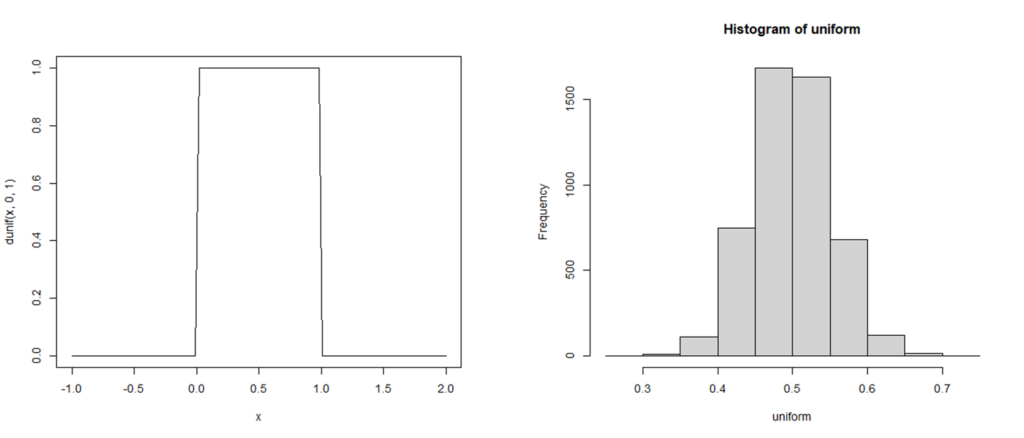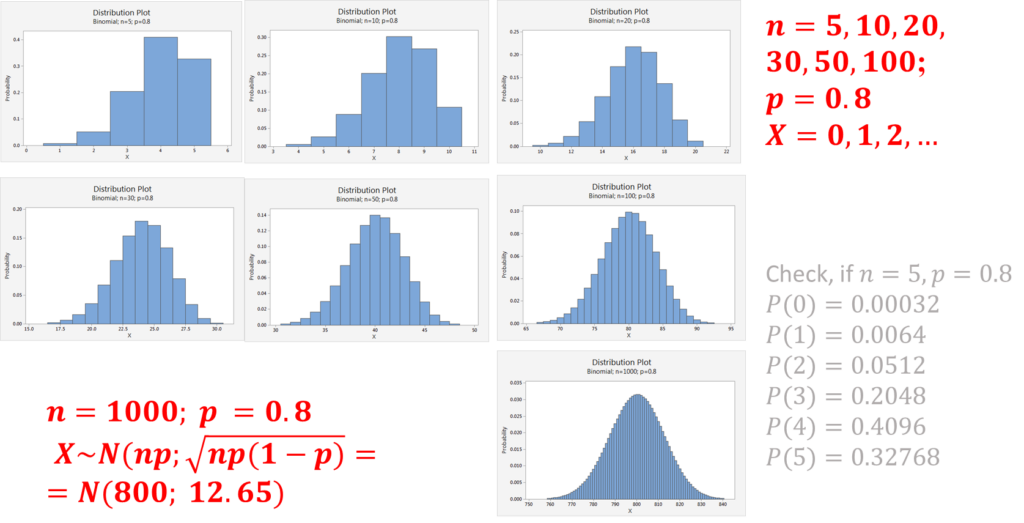Sampling distributions
(Keller 9)
A sample of size ![]() is just one of many possible samples of size
is just one of many possible samples of size ![]() . If
. If ![]() is the population size and
is the population size and ![]() the sample size (
the sample size (![]() ≪
≪![]() ) then the number of possible different samples equals
) then the number of possible different samples equals ![]()
This number of samples is usually very large. For example, from a population of 1000 objects the number of different samples of size 25 equals ![]() .
.
Most samples have (different) random statistics, e.g. ![]() or
or ![]() . These sample statistics have a probability distribution, the so-called sampling distribution.
. These sample statistics have a probability distribution, the so-called sampling distribution.
Some mathematics
![]() and
and ![]() are sample statistics. Let us derive the distribution function of
are sample statistics. Let us derive the distribution function of ![]() . We know that
. We know that ![]() and
and ![]() . Then:
. Then:
![]()
![]()
![]()
So, for the random variable ![]() it holds:
it holds: ![]() and
and ![]()
Earlier we defined for any random variable ![]() :
:
![]()
and thus for the random variable ![]() we get:
we get:
![]()
Central Limit Theorem
(Keller 7, 8, 9)
The theorem states that he sampling distribution of the means of random samples drawn from any population is approximately normal for a sufficiently large sample size ![]() . The larger the sample size, the more closely the sampling distribution of
. The larger the sample size, the more closely the sampling distribution of ![]() will resemble a normal distribution.
will resemble a normal distribution.
We will not prove the Central Limit Theorem here, that will be beyond the scope of this crash course. However, we try to make this theorem plausible by verifying it in a number of examples.
If the distribution of the population is normal, then ![]() is normally distributed for all sample sizes
is normally distributed for all sample sizes ![]() . If the population is non-normal, then
. If the population is non-normal, then ![]() is approximately normal only for larger values of
is approximately normal only for larger values of ![]() . In most practical situations, a sample size of
. In most practical situations, a sample size of ![]() may be sufficiently large to allow us to use the normal distribution as an approximation for the sampling distribution of
may be sufficiently large to allow us to use the normal distribution as an approximation for the sampling distribution of ![]() .
.
Verify Central Limit Theorem (may be skipped)
(Keller 9)
The following is a program in pseudo code.
- Take a first sample of size
 of a uniform distribution and compute its sample mean
of a uniform distribution and compute its sample mean  ;
; - Repeat this
 times and thus get
times and thus get  sample means
sample means  . Also these means are random variables;
. Also these means are random variables; - According to the Central Limit Theorem these
 random means should be (approximately) normally distributed;
random means should be (approximately) normally distributed; - Verify this graphically by drawing a histogram;
- Verify this by applying a normality test (e.g. Anderson-Darling);
- Repeat 1-5 for
 and notice the differences.
and notice the differences.
The actual program is executed by the programming language R but any programming language will so. Thc code of the R program is as follows:
# Suppose x has a uniform distribution
# n is the sample size, preferably n = 30
n <- 30
# k is the number of such sample means, sufficiently large, e.g. k = 5000
k <- 5000
# According to the Central Limit Theorem
# the k sample means should approximate a normal distribution
z <- numeric(k) # z is a vector with k elements and will contain all k sample means
for (j in 1:k) (z[j] <- mean(runif(n))) # compute the mean of each uniform sample
# show the histogram of these means
hist(z)
# and find out whether the distribution of means is normal
# which is approximately true for n ≥ 30
ad.test(z) # Anderson-Darling test
The result is as follows.
The left graph represents a uniform distribution on ![]() ; the right graph depicts a histogram of
; the right graph depicts a histogram of ![]() sample means which is rather good approximation of a normal distribution.
sample means which is rather good approximation of a normal distribution.

Using the standard normal distribution
(Keller 9)
Suppose the population random variable ![]() is normally distributed with
is normally distributed with ![]() and
and ![]() .
.
We take a sample of size ![]() drawn from the population. The sample mean is denoted by
drawn from the population. The sample mean is denoted by ![]() . We want to compute
. We want to compute ![]() .
.
We know:
![]() is normally distributed, therefore so will be
is normally distributed, therefore so will be ![]() .
.
![]() and
and ![]()
![]()
![]()
The answer can be found in Table 3 of Appendix B9 of Keller.
The difference of two means
(Keller 9)
Consider the sampling distribution of the difference ![]() of two sample means.
of two sample means.
If the random samples are drawn from each of two independent normally distributed populations, then ![]() will be normally distributed as well with:
will be normally distributed as well with:
![]()
![]()
![]()
If two populations are not both normally distributed, and the sample sizes are large enough (![]() ), then in most cases the distribution of
), then in most cases the distribution of ![]() is approximately normal (see the Central Limit Theorem).
is approximately normal (see the Central Limit Theorem).
Normal approximation to Binomial
There are circumstances that a Binomial distribution may be approximated by a normal distribution. Let us look at the following example: a binomial distribution with ![]() and
and ![]() (so
(so ![]() and
and ![]() ) superimposed by a normal distribution
) superimposed by a normal distribution ![]() ).
).
The graph shows ![]() and the graph of a
and the graph of a ![]() distribution.
distribution.

The normal approximation to binomial works best when the number of experiments ![]() is large and the probability of succes
is large and the probability of succes ![]() is close to
is close to ![]() .
.
For the approximation to provide acceptable results two conditions should be met:
![]() and
and ![]()
Example
The following graph shows the approximations witp ![]() and various values of
and various values of ![]() .
.

Example
How accurate is the approximation?
For a binomial distribution (![]() we find (using Excel):
we find (using Excel):![]() .
.
For a normal distribution (![]() ) we find:
) we find:![]() (continuity correction), which is pretty close to the exact value.
(continuity correction), which is pretty close to the exact value.
Distribution of a sample proportion
The estimator of a population proportion of successes is the sample proportion. That is, we count the number of successes in a sample of size ![]() and compute:
and compute:
![]()
![]() is the number of successes,
is the number of successes, ![]() is the sample size. Note that the random variable
is the sample size. Note that the random variable ![]() has a binomial distribution.
has a binomial distribution.
Using the laws of expected value and variance, we can determine the mean, variance and standard deviation. Sample proportions can be standardized to a standard normal distribution using the formula:
![]() and thus
and thus ![]()
Note.
Binomial disribution: ![]()
![]()
![]()
and thus:
![]()
Example
In the last election a state representative received ![]() % of the votes (so
% of the votes (so ![]() ; this can be considered as a population parameter!)
; this can be considered as a population parameter!)
One year after the election the representative organized a survey that asked a random sample of ![]() people whether they would vote for him in the next election.
people whether they would vote for him in the next election.
If we assume that his popularity has not changed what is the probability that more than half of the sample would vote for him?
The number of respondents who would vote for the representative is a binomial random variable with ![]() and
and ![]() and we want to determine the probability that the sample proportion is greater than
and we want to determine the probability that the sample proportion is greater than ![]() %, That is, we want to compute
%, That is, we want to compute ![]() .
.
From the foregoing we know that the sample proportion ![]() is approximately normally distributed with mean
is approximately normally distributed with mean ![]() and standard deviation
and standard deviation ![]()
Thus we compute:
![]()
![]()
![]()
If we assume that the level of support remains at ![]() % the probability that more than half the sample of
% the probability that more than half the sample of ![]() people would vote for the representative is
people would vote for the representative is ![]() %.
%.

